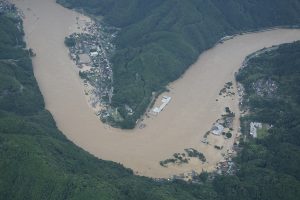A week of torrential rain pounded southwestern and central Japan, triggering severe flooding and landslides that have killed at least 68 people in the region. Kumamoto prefecture in Japan’s southern island of Kyushu has been hardest hit, and over the weekend residents braced for more extreme weather. On Saturday some areas observed more than 80 millimeters of rainfall per hour and 1,000 mm over three consecutive days. Strong winds, lightning, and tornadoes were also added to the weather warning. The Ministry of Land reported 282 mudslide disasters across 27 prefectures with the largest number, 52, in Kumamoto prefecture.
Eastern and western Japan are on high alert for heavy 24-hour downpours with a risk that rivers in Iwate and Aomori could overflow. New mudslide warnings have also been issued for Kyushu as past rain loosens the ground and damaged river levees inundate low-lying areas.
Residents have been urged to secure their safety, with authorities stressing that conditions can suddenly deteriorate with the stopping and starting of heavy rains. As of Saturday, 2,909 people were staying in evacuation shelters across eight prefectures. On Kyushu Island, 283 people in Kumamoto were trapped after roads were damaged.
On Saturday local authorities warned that the water level of the Kuma River, which stretches across Kumamoto prefecture, was rapidly rising and the river was at risk of bursting its banks again. On July 4, the Kuma River overflowed in seven locations, with rapid flooding trapping some 3,000 households. Disaster-affected communities in mountainous areas were cut off due to collapsed roads and highways and large debris which caused disruptions to phone lines. Floodwaters reportedly reached as high as 4.3 meters in some areas, damaging about 10,000 homes and also washing away cars, railway lines, and a bridge.
Japan’s Meteorological Agency says the atmospheric conditions remain unstable over a wide area from western Japan to Tohoku as a result of an active weather front and low pressure system extending over the East China Sea to the Sea of Japan. Local heavy rains are expected to continue for 12 to 15 days.
Search and rescue efforts for 13 missing people, mainly in Kumamoto, are being hampered by intermittent heavy rains. Bad weather has delayed helicopter aerial searches as well the construction of temporary individual emergency shelters. Volunteers who arrived to help with the clean up of damaged houses were sent home after locals in Hitoyoshi city were ordered to evacuate via radio. Despite that, Japan’s disaster management minister made a public appeal for volunteers, saying the COVID-19 pandemic has affected recruitment numbers.
This year, managing the rainy season was complicated by the spread of coronavirus. Volunteers are being restricted to their own prefecture, which has created a shortage of manpower. Meanwhile, evacuation centers also pose a dangerous risk for COVID-19 clusters as continued heavy rains prolong evacuees’ stay. In preparation, authorities opened more evacuation shelters to help reduce crowd density. Socially distanced cardboard partitions have also been set up around groups of evacuees.
Japan’s rainy season is the milder precursor to a notoriously hot and humid summer. While the rainy season varies depending on the region and year, generally falling from late May to late July, heavy rains that lead to major disasters tend to happen toward the end of the season, from late June to late July. However, the intensifying level of damage and death toll in recent years has been linked to the fallout of global warming. As temperatures and sea levels rise, large amounts of water vapor from the East China Sea and South China Sea form a “river of atmospheric water vapor,” leading to the near-annual occurrence of severe rainstorms and torrential rains.
Devastation from strong winds and floods has brought an inflow of sediment into paddy fields and flood water to farmland, damaging rice crops for harvest season. Last Thursday Prime Minister Shinzo Abe declared this year’s rainy season as a “violent disaster” and pledged financial support to local municipalities to ease the burden of recovery and rebuilding. At this stage the full extent of the damage is unknown, but Abe said authorities would speed up inspections to calculate the price tag of the destruction.

































